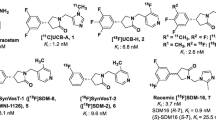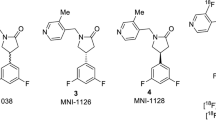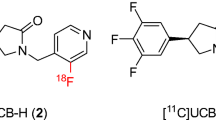Abstract
Purpose
Current synaptic vesicle 2A (SV2A) positron emission tomography (PET) imaging agents include the nanomolar affinity probes [11C]UCB-J and [18F]UCB-H derived from the anti-epileptic drug levitaracetam (Keppra®). An industry-utilized “de-risking” approach was used to carry out initial pharmacological characterization and to assess potential next-generation candidates amenable to F-18 radiolabeling for preliminary evaluation.
Procedures
Radioligand binding methods were employed in mammalian brain homogenates to determine the SV2A affinity (Kd) and maximal binding capacity (Bmax) of [3H]UCB-J. Novel leads were then screened to identify compounds minimally with comparable binding affinities with UCB-J in order to select a F-18-labeled candidate for subsequent in vivo assessment in rat. In parallel, mammalian brain tissue section autoradiography was performed to assess specific SV2A distribution.
Results
[3H]UCB-J bound with high affinity to a single population of sites in the rat brain (Kd = 2.6 ± 0.25 nM; Bmax = 810 ± 25 fmol/mg protein) and control human cortex (Kd = 2.9 ± 0.54 nM; Bmax = 10,000 ± 640 fmol/mg protein). Distribution of specific SV2A binding was shown to be homogeneous throughout the rodent brain and primarily in gray matter regions of rodent and human brain sections. Analog screening identified MNI-1038, MNI-1126/SDM-8, and SDM-2 as having comparable binding affinities with the currently available PET ligands. Subsequent [18F]MNI-1126/[18F]SDM-8 dynamic micro-PET imaging in rats revealed in vivo uptake and accumulation in the brain with favorable kinetics. Chase studies using 30 mg/kg levetiracetam confirmed that in vivo brain uptake of [18F]MNI-1126/[18F]SDM-8 was reversible.
Conclusions
Taken together, these data suggest [18F]MNI-1126/[18F]SDM-8 (since renamed as [18F]SynVesT-1) characterized via an in vitro screening cascade provided a measurable in vivo SV2A specific signal in the rodent brain. This tracer as well as the close analog [18F]SDM-2 (since renamed as [18F]SynVesT-2) is currently undergoing further evaluation in preclinical and clinical studies.






Similar content being viewed by others
References
Bajjalieh SM, Frantz GD, Weimann JM, McConnell S, Scheller RH (1994) Differential expression of synaptic vesicle protein 2 (SV2) isoforms. J Neurosci 14:5223–5235
Crowder KM, Gunther JM, Jones TA, Hale BD, Zhang HZ, Peterson MR, Scheller RH, Chavkin C, Bajjalieh SM (1999) Abnormal neurotransmission in mice lacking synaptic vesicle protein 2A (SV2A). Proc Natl Acad Sci 96:15268–15273
Jahn R, Fasshauer D (2012) Molecular machines governing exocytosis of synaptic vesicles. Nature 490:201–207
Mendoza-Torreblanca JG, Vanoye-Carlo A, Phillips-Farfán BV et al (2013) Synaptic vesicle protein 2A: basic facts and role in synaptic function. Eur J Neurosci 38:3529–3539
Vogl C, Tanifuji S, Danis B, Daniels V, Foerch P, Wolff C, Whalley BJ, Mochida S, Stephens GJ (2015) Synaptic vesicle glycoprotein 2A modulates vesicular release and calcium channel function at peripheral sympathetic synapses. Eur J Neurosci 41:398–409
Lynch BA, Lambeng N, Nocka K, Kensel-Hammes P, Bajjalieh SM, Matagne A, Fuks B (2004) The synaptic vesicle protein SV2A is the binding site for the antiepileptic drug levetiracetam. Proc Natl Acad Sci U S A 101:9861–9866
Kenda BM, Matagne AC, Talaga PE, Pasau PM, Differding E, Lallemand BI, Frycia AM, Moureau FG, Klitgaard HV, Gillard MR, Fuks B, Michel P (2004) Discovery of 4-substituted pyrrolidone butanamides as new agents with significant antiepileptic activity. J Med Chem 47:530–549
von Rosenstiel P (2007) Brivaracetam (UCB 34714). Neurotherapeutics 4(1):84–87
Ohno Y, Tokudome K (2017) Therapeutic role of synaptic vesicle glycoprotein 2A (SV2A) in modulating epileptogenisis. CNS Neurol Disord Drug Targets 16:463–471
Löscher W, Gillard M, Sands ZA, Kaminski RM, Klitgaard H (2016) Synaptic vesicle glycoprotein 2A ligands in the treatment of epilepsy and beyond. CNS Drugs 30:1055–1077
Lever SZ, Fan KH, Lever JR (2017) Tactics for preclinical validation of receptor-binding radiotracers. Nucl Med Biol 44:4–30
Hargreaves RJ, Hoppin J, Sevigny J, Patel S, Chiao P, Klimas M, Verma A (2015) Optimizing central nervous system drug development using molecular imaging. Clin Pharmacol Ther 98:47–60
Patel S, Hamill TG, Connolly B, Jagoda E, Li W, Gibson RE (2007) Species differences in mGluR5 binding sites in mammalian central nervous system determined using in vitro binding with [18F]F-PEB. Nucl Med Biol 34:1009–1017
Patel S, Ndubizu O, Hamill T, Chaudhary A, Burns HD, Hargreaves R, Gibson RE (2005) Screening cascade and development of potential positron emission tomography radiotracers for mGluR5: in vitro and in vivo characterization. Mol Imaging Biol 7:314–323
Patel S, Hammil T, Hostetler E et al (2003) An invitro assay for predicting successful imaging radiotracers. Mol Imaging Biol 5:65–71
Patel S, Gibson R (2008) In vivo site-directed radiotracers: a mini-review. Nucl Med Biol 35:805–815
Gillard M, Fuks B, Leclercq K, Matagne A (2011) Binding characteristics of brivaracetam, a selective, high affinity SV2A ligand in rat, mouse and human brain: relationship to anti-convulsant properties. Eur J Pharmacol 664:36–44
Warnier C, Lemaire C, Becker G, Zaragoza G, Giacomelli F, Aerts J, Otabashi M, Bahri MA, Mercier J, Plenevaux A, Luxen A (2016) Enabling efficient positron emission tomography (PET) imaging of synaptic vesicle glycoprotein 2A (SV2A) with a robust and one-step adiosynthesis of a highly potent 18F-labeled ligand ([18F]UCB-H). J Med Chem 59:8955–8966
Nabulsi NB, Mercier J, Holden D, Carre S, Najafzadeh S, Vandergeten MC, Lin SF, Deo A, Price N, Wood M, Lara-Jaime T, Montel F, Laruelle M, Carson RE, Hannestad J, Huang Y (2016) Synthesis and preclinical evaluation of 11C-UCB-J as a PET tracer for imaging the synaptic vesicle glycoprotein 2A in the brain. J Nucl Med 57:777–784
Finnema SJ, Nabulsi NB, Eid T, Detyniecki K, Lin SF, Chen MK, Dhaher R, Matuskey D, Baum E, Holden D, Spencer DD, Mercier J, Hannestad J, Huang Y, Carson RE (2016) Imaging synaptic density in the living human brain. Sci Transl Med 8:348ra96
Finnema SJ, Nabulsi NB, Mercier J, Lin SF, Chen MK, Matuskey D, Gallezot JD, Henry S, Hannestad J, Huang Y, Carson RE (2018) Kinetic evaluation and test-retest reproducibility of [11C]UCB-J, a novel radioligand for positron emission tomography imaging of synaptic vesicle glycoprotein 2A in humans. J Cereb Blood Flow Metab 38:2041–2052
Li S, Cai Z, Wu X, Holden D, Pracitto R, Kapinos M, Gao H, Labaree D, Nabulsi N, Carson RE, Huang Y (2019) Synthesis and in vivo evaluation of a novel PET radiotracer for imaging of synaptic vesicle glycoprotein 2A (SV2A) in nonhuman primates. ACS Chem Neurosci 10:1544–1554
Cheng Y, Prusoff WH (1973) Relationship between the inhibition constant (Ki) and the concentration of inhibitor which causes 50 per cent inhibition (I50) of an enzymatic reaction. Biochem Pharmacol 22:3099–3108
Patel S, Hamill T, Hostetler E et al (2003) An in-vitro assay for predicting successful imaging radiotracers. Mol Imaging Biol 5:65–71
Nicolas JM, Hannestad J, Holden D, Kervyn S, Nabulsi N, Tytgat D, Huang Y, Chanteux H, Staelens L, Matagne A, Mathy FX, Mercier J, Stockis A, Carson RE, Klitgaard H (2016) Brivaracetam, a selective high-affinity synaptic vesicle protein 2A (SV2A) ligand with preclinical evidence of high brain permeability and fast onset of action. Epilepsia 57:201–209
Eckelman WC, Gibson RE (1993) The design of site-directed radiopharmaceuticals for use in drug discovery. In: Burns HD, Gibson RE, Dannals R, Siegl P (eds) Nuclear imaging and drug discovery, development and approval. Birkhauser, Boston, pp 114–134
Chen MK, Mecca AP, Naganawa M, Finnema SJ, Toyonaga T, Lin SF, Najafzadeh S, Ropchan J, Lu Y, McDonald JW, Michalak HR, Nabulsi NB, Arnsten AFT, Huang Y, Carson RE, van Dyck CH (2018) Assessing synaptic density in Alzheimer disease with synaptic vesicle glycoprotein 2A positron emission tomographic imaging. JAMA Neurol 75:1215–1224
Dawson TM, Golde TE, Lagier-Tourenne C (2018) Animal models of neurodegenerative diseases. Nat Neurosci 21:1370–1379
Sasaguri H, Nilsson P, Hashimoto S, Nagata K, Saito T, de Strooper B, Hardy J, Vassar R, Winblad B, Saido TC (2017) APP mouse models for Alzheimer’s disease preclinical studies. EMBO J 36:2473–2487
Constantinescu CC, Tresse C, Zheng M, Gouasmat A, Carroll VM, Mistico L, Alagille D, Sandiego CM, Papin C, Marek K, Seibyl JP, Tamagnan GD, Barret O (2019) Development and in vivo preclinical imaging of fluorine-18-labeled synaptic vesicle protein 2A (SV2A) PET tracers. Mol Imaging Biol 21:509–518
Author information
Authors and Affiliations
Corresponding author
Ethics declarations
Conflict of Interest
The authors declare that they have no conflict of interest.
Additional information
Publisher’s Note
Springer Nature remains neutral with regard to jurisdictional claims in published maps and institutional affiliations.
Electronic Supplementary Material
ESM 1
(PDF 341 kb)
Rights and permissions
About this article
Cite this article
Patel, S., Knight, A., Krause, S. et al. Preclinical In Vitro and In Vivo Characterization of Synaptic Vesicle 2A–Targeting Compounds Amenable to F-18 Labeling as Potential PET Radioligands for Imaging of Synapse Integrity. Mol Imaging Biol 22, 832–841 (2020). https://doi.org/10.1007/s11307-019-01428-0
Published:
Issue Date:
DOI: https://doi.org/10.1007/s11307-019-01428-0




